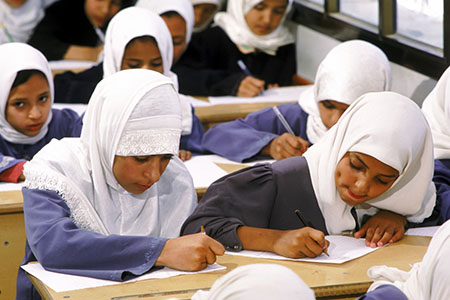
Students taking year end exams at Kardi School in Sana'a, Yemen. Photo: Bill Lyons / World Bank
The Arab World Learning Barometer is an interactive tool developed by the Center for Universal Education at Brookings. Using the latest available data, the barometer provides a snapshot of the state of education and learning in the Middle East and North Africa.
The barometer measures the quality of education and learning by examining four areas: getting into school, staying in school, whether students are learning basic skills while in school, and the link between education and youth unemployment. The barometer brings together often scarce data for 20 countries in the Arab region. The data cover the 2001-2012 period and do not reflect setbacks due to recent conflicts in the region.
I. Getting into School
II. Staying in School
III. Learning
IV. Youth Unemployment
Getting into School
Getting children into school is the first step in education and learning. The number of primary-age children out of school in the Arab world has declined significantly over the past decade from 6.8 million in 2002 to 4.8 million in 2011. Improvements have also been seen at the secondary level, with the number of out-of-school adolescents falling by more than 1 million, from 4.9 million in 2002 to 3.8 million in 2011.
But progress is fragile. About 8.5 million children and youth are out of school in the region at the primary and secondary level (having never enrolled or dropped out prematurely). Many of them are girls from poor, rural communities often living in regions affected by conflict. Reaching the millions of primary-age children and youth excluded from school in the Arab world is critical to attaining the second Millennium Development Goal of universal primary school enrollment by 2015.
Out-of-school children of primary school age, 1999 - 2011
Show:
Staying in School
More children are enrolling in and finishing primary school in the Arab world than ever before. While there is variation in the region, disparities across countries appear to be narrowing, largely due to substantial improvements in Arab countries with low rates of education participation. For countries with available data, the majority have primary school survival rates above 90 percent.
Enrollment and Survival Rates for Primary School, 2001-2002 and 2010-2011
Light green bars are 2001-2002 values; dark green are 2010-2011. Asterisks indicate unavailable data.
Sort by:
Show:
Secondary school enrollment has also improved significantly, though data is much more limited. But the picture for school completion of lower secondary school is less positive, with more youth dropping out than a decade ago. For several countries, the data suggest a declining trend in lower secondary school survival rates.
Enrollment and Survival Rates for Lower Secondary School, 2001-2002 and 2010-2011
Light green bars are 2001-2002 values; dark green are 2010-2011. Asterisks indicate unavailable data.
Sort by:
Show:
Learning
Over half of children in school are not acquiring foundational skills
Progress in school enrollment masks the crisis of learning in the Arab region. In many cases, even those who do attend and stay in school are not receiving a good-quality education and therefore not learning. Minimum competency thresholds from international literacy and numeracy assessments at the Grade 4 and Grade 8 level are used to determine the share of children not learning. Children falling below these thresholds cannot read or write fluently or perform basic numeracy functions. Based on 13 Arab countries with available data:
- Fifty-six percent of primary students and 48 percent of secondary students are not meeting basic learning levels.
- The learning crisis affects boys significantly more than girls. The share of boys in school that do not meet basic learning levels is higher than girls in almost every country in the region with available data.
- On average, rural children do not perform as well as their urban counterparts, and overlapping disparities based on income, gender and geographic location create stark divisions.
Composite Learning Score, Primary School
Darker colors indicate less learning. "N/A" indicates unavailable data. Click a country to learn more. (If you are on a touch screen device, tap once to select the country whose data you want to see, and tap again after the country's name appears to reveal the data in the box below.)
Show:
Youth Unemployment
The learning crisis and lack of skills acquisition among Arab youth in the region have direct links to the wider unemployment challenges in the Middle East and North Africa. Unemployment, particularly for youth, is distressingly high across Arab countries and gender disparities are stark. There is a “boomerang” effect for girls, meaning that while they are less likely to enter school than boys, they are more likely to make the transition from primary to secondary school, and they tend to outperform boys in terms of learning. Yet, young adult women are much less likely to be employed than men. Labor force participation is particularly low for women, with an average of 24.1 percent compared with 77.2 percent for men. The low female participation rate, together with high unemployment, means that only about 18 percent of working-age Arab women actually have jobs.
Youth labor force participation
Darker colors indicate higher youth labor force participation. Click a country to learn more. Asterisks indicate unavailable data. (If you are on a touch screen device, tap once to select the country whose data you want to see, and tap again after the country's name appears to reveal the data in the box below.)